Loren C. Steffy's Blog, page 15
October 21, 2013
Charleston and the Ship Model Jesus
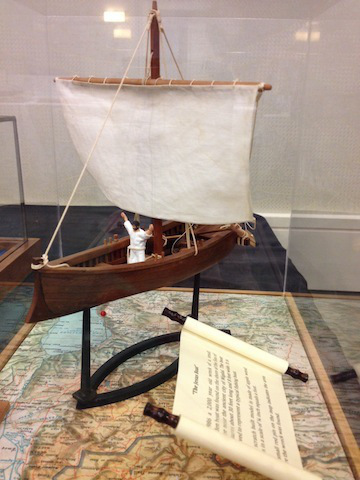 Last week, I was in Charleston, S.C., to speak to the Nautical Research Guild about my father’s Egyptian ship model and how he used models in researching ancient ship construction. The guild is a national group of ship modelers and other ship enthusiasts that’s been around since 1948, and its members had some incredible models on display. As I was walking around the exhibits, I spotted this one, which is the Sea of Galilee Boat, complete with a tiny ship model Jesus ahead of the mast.
Last week, I was in Charleston, S.C., to speak to the Nautical Research Guild about my father’s Egyptian ship model and how he used models in researching ancient ship construction. The guild is a national group of ship modelers and other ship enthusiasts that’s been around since 1948, and its members had some incredible models on display. As I was walking around the exhibits, I spotted this one, which is the Sea of Galilee Boat, complete with a tiny ship model Jesus ahead of the mast.
My father and others who worked on the project were always careful to say that the first-century fishing boat, found on the shores of the Sea of Galilee in Israel, may have been similar to the one that Jesus used, but there is no evidence that it is the boat referred to in the Bible. Also, there’s no record of Jesus owning a boat. Nevertheless, the vessel has become known as the “Jesus Boat,” and the tiny ship model Jesus seemed to be a nod to the savvy marketing of the project.
Nearby was a model of a bireme in a perfume bottle. It reminded me of a model I mentioned in The Man Who Thought Like a Ship. My father built a tiny frigate in a hollowed out flashlight bulb. He used strands of my mother’s hair for the rigging. He had to build special tools to do it, and he displayed it at a hobby fair under a magnifying glass. Sadly, like so many of his models, that one is lost to the ages.
The modeler who built both the bireme and the Jesus Boat also told me there’s a model kit of the Kyrenia Ship available on the Internet. I had no idea. I’m certainly not the ship modeler my father was, but I’m tempted to try my hand at this just for the sheer irony of it. After all, it appears this model is patterned after Kyrenia II, the full-scale replica built in the 1980s. That ship was built using the lines drawings my father made for the reconstruction of the original Greek merchant ship from 300 BC.


October 16, 2013
Texas A&M, Israel and the `Jesus Boat’
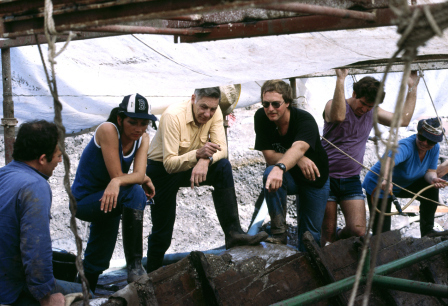
My father, in the yellow shirt, and Shelley Wachsmann, pointing in the black shirt, studying the Sea of Galilee Boat in situ.
Texas A&M University may be considering a campus in Israel, according to the Bryan/College Station Eagle. Citing “sources close to the situation,” the paper said A&M officials have made repeated trips to Israel to negotiate a partnership and that an announcement could come as early as next week.
In fact, A&M has had a long-standing connection to Israel through the Institute of Nautical Archaeology. My father was a visiting professor at the University of Haifa beginning in 1981, and he studied the Athlit Ram, a battering ram that adorned the bow of a oared war ship from the Hellenistic period.
My father continued working on the ram for the next several years, studying the timbers under its bronze casing. In 1986, he returned to Israel at the request of Shelley Wachsmann to examine a boat found on the shores of the Sea of Galilee. The excavation revealed it was a fishing boat from the first century, similar to the one mentioned in the Bible that was used by Jesus.
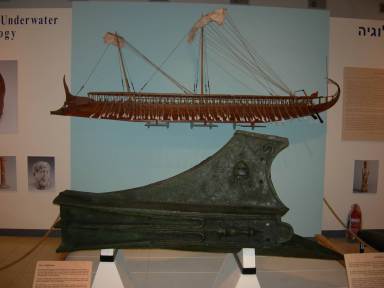
The Athlit Ram on display with a drawing of the warship from which it came behind it.
Today, the “Jesus Boat” is a top tourist attraction in Israel, and Shelley Wachsmann is a professor in the nautical archaeology program at Texas A&M.
In The Man Who Thought Like a Ship, I discuss both the Athlit Ram and Sea of Galilee boat in more detail, and Wachmann’s own excellent book tell’s the boat’s story in full.
In the 1990s, my father consulted on two other significant archaeological projects in Israel: the Ma’agan Micheal excavation of a cargo ship from about 400 BC and the recovery of multiple shipwrecks from the Tantura Lagoon.
If A&M is looking for program upon which to build its Israeli campus, it might look to its own history.


October 14, 2013
The `Lost Ship Model’ is finally home
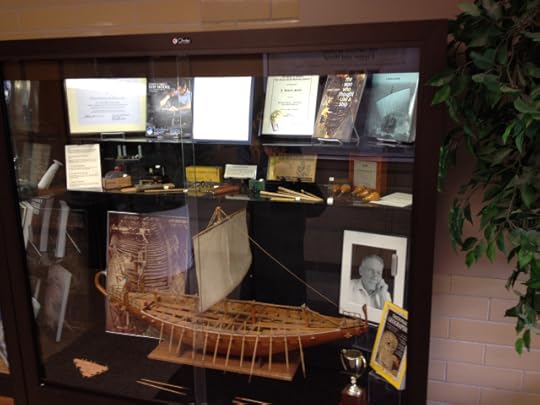 Last week, I was on the Texas A&M University campus, and I stopped by the headquarters of the Institute of Nautical Archaeology to see the display of the “Lost Ship Model.” The rendering of an Egyptian ship from about 1400 BC was my father’s first true research model and figures prominently in The Man Who Thought Like a Ship. Presumed to have deteriorated or been discarded decades ago, it was discovered last year in Philadelphia.
Last week, I was on the Texas A&M University campus, and I stopped by the headquarters of the Institute of Nautical Archaeology to see the display of the “Lost Ship Model.” The rendering of an Egyptian ship from about 1400 BC was my father’s first true research model and figures prominently in The Man Who Thought Like a Ship. Presumed to have deteriorated or been discarded decades ago, it was discovered last year in Philadelphia.
The new display includes not only the model but some of the tools that my father used to build it, as well as the hobby show trophy he won for it in 1963. The display is rounded out with a photo of the Kyrenia Ship reconstruction, a copy of my father’s MacArthur Foundation award certificate and the July 1963 issue of National Geographic, which contains the article that prompted my father to first write to George Bass and propose using models to reconstruct ancient shipwrecks.
It’s taken more than a year to complete the display because of renovations to the nautical archaeology building at A&M. It’s gratifying to see that the “Lost Ship Model” has finally found its home.


October 12, 2013
Had a great time discussing `truth in th
Had a great time discussing `truth in the age of non-fiction’ with other authors and students at #TexasA&M yesterday http://ow.ly/pL0YO


October 2, 2013
Truth in the Age of Nonfiction
I’ll be participating in a panel discussion as part of a symposium on nonfiction writing at Texas A&M University on Oct. 11.
Sponsored by the Journalism Studies Program, the event, which is open to the public, kicks off with a keynote by James McGrath Morris, author of Pulitzer: A Life in Politics, Print and Power.
At 11 a.m., I’ll be joined on a panel with former Austin American-Statesman writer Denise Gamino, co-author of Around the World with LBJ: My Wild Ride as Air Force One Pilot, White House Aide, and Personal Confidant. We’ll discuss using fiction techniques to bring nonfiction writing to life.
We’ll have a book signing after the discussion and lunch. The program will be in Rudder Tower on the A&M campus. Here’s more information on the event and how to register. Hope to see you there.


September 30, 2013
The Cornwallis Connection

Charles Cornwallis, First Marquis of Cornwallis (1738 – 1805) (Photo credit: Wikipedia)
Last week, I was walking around downtown Charlotte, N.C.. Standing in front of the Bank of America tower, I noticed a marker indicating I was at the site of the Battle of Charlotte, which occurred on Sept. 26, 1780.
Back then, it was the site of the Mecklenburg County Courthouse, at the intersection of the town’s two main roads. An advance guard of British troops rode into town and found themselves confronted by a well-armed Patriot force. The Patriots fought off the guard, then withdrew as the far larger main army of British General Charles Cornwallis advanced on the city. Cornwallis’ attempts to occupy Charlotte, though, never really succeeded, thanks to persistent Patriot resistance and he eventually withdrew to South Carolina.
As I continued my walk around downtown Charlotte, my thoughts drifted from the battle to Cornwallis to an old NASA missile retriever docked near Yorktown, Va. — a roundabout connection between the British general and my father, and story that I didn’t include in The Man Who Thought Like a Ship.
In the summer of 1975, I was involved in one of the great boyhood rites of passage. My father was teaching me to use a lawn mower. We were in our back yard in Pennsylvania, and I’d made my first pass under my father’s supervision when my mother came out the house and told my dad he had a phone call. We turned the mower off, and I waited, anxious to get back to the tutorial. (My interest was economic. Lawn mowing was a chore my parents paid for, and with my brother heading to college, I was eager to step into the gig.)
When he returned, though, my father had another idea: how would I like to come with him and spend the weekend on a boat in Virginia?
Our destination was Gloucester Point, at the mouth of the York River. Working with the Virginia Institute of Marine Sciences, members of the fledgling Institute of Nautical Archaeology were consulting on the excavation of Revolutionary ships from the Battle of Yorktown, which essentially ended the Revolutionary War.
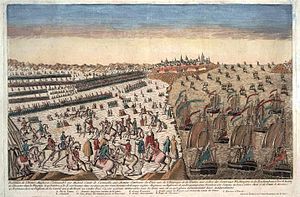
Overview of the capitulation of the British army at Yorktown, with the blockade of the French squadron. (Photo credit: Wikipedia)
About a year after the Battle of Charlotte, on Oct. 19, 1781, Cornwallis had moved his fleet to the York River and found himself hemmed in by land and sea and surrendered to George Washington. Before the surrender, Cornwallis, who still had about 60 ships at his disposal, ordered some of them scuttled at the mouth of the river in a desperate attempt to stave off the approaching French fleet.
We spent the weekend on an old boat that NASA had used to retrieve missiles after test flights. The space agency donated it to the school, which was using it as a dive boat. For a 9-year-old boy, it proved an exciting weekend playground.
Several of the scuttled ships were found as a result of those meetings and five years later, a team lead by archaeologist John Broadwater found the HMS Charon, Cornwallis’ flagship. The Charon caught fire and sank in the York River in the final days of the war. My father directed the INA field school that helped excavate the Charon in the summer of 1980. It was the only field project he ever directed. He didn’t enjoy the administrative side of archaeological projects, but he later told his colleague, George Bass, that he wanted to do it to prove to himself that he could.
Cannons and other artifacts from the Charon and other ships from the “sunken fleet” excavated in the York River are on display in Yorktown, and the river continues to yield new discoveries.


September 27, 2013
I can’t keep up with changes in technol
I can’t keep up with changes in technology. Stayed up late last night to finally download #IOS7, and this morning, there was a new update.


September 23, 2013
`Steffy’s First Ship Model’
 The latest issue of the INA Quarterly has a couple of items about which I’m excited. The first is the cover story, “Steffy’s First Ship Model,” which is a reworked version of the story I wrote last year for the Houston Chronicle. It tells of my search for my father’s first research model, which was assumed to have been lost in the 1960s. Instead, it turned up in the store room of a Philadelphia museum. This version of the story has more photos, including the wonderful cover shot and one of me, at age seven, helping to cut treenails for a 1:5 model of the Kyrenia Ship.
The latest issue of the INA Quarterly has a couple of items about which I’m excited. The first is the cover story, “Steffy’s First Ship Model,” which is a reworked version of the story I wrote last year for the Houston Chronicle. It tells of my search for my father’s first research model, which was assumed to have been lost in the 1960s. Instead, it turned up in the store room of a Philadelphia museum. This version of the story has more photos, including the wonderful cover shot and one of me, at age seven, helping to cut treenails for a 1:5 model of the Kyrenia Ship.
The story also comes with an update: Late this summer, the model completed its journey from Philadelphia. It had been at my house for almost a year while renovations to the nautical archaeology building at Texas A&M were completed. I recently drove the model on the final leg of its journey from my home near Houston to College Station. Some cosmetic work is being done on the 50-year-old model, and it will soon be on display.
The INA Quarterly issue also has a review of The Man Who Thought Like a Ship by Sheila Matthews, who was one of my father’s first students. I interviewed Sheila for the book, and she probably knew my father’s methods better than anyone. I have found myself most nervous about reviews of the book by my father’s friends and peers. From the moment I began working on the manuscript, I worried that I wouldn’t get the details of his work correct, or worse, that I would make some broader error about archaeology.
I’m grateful that the feedback I’ve received from my father’s colleagues, including Sheila, has been positive. In the review, Sheila says that I was able to capture my father’s essence, “recalling with fondness his humor, quiet passion, and determination — traits well known to those of us who were fortunate enough to work with him.”
You can find more information on INA and get a full issue of the INA Quarterly, here.


September 20, 2013
The Wealthiest Texans list

(Photo credit: Wikipedia)
The latest issue of Texas Monthly has its annual list of wealthiest Texans. Many of the subjects of these sorts of lists hate them. They would prefer to be known for their achievements, their success or their charity rather than simply for their wealth.
Wealth, of course, can be a measure of success and achievement, but certainly with a lengthy list like this one, there isn’t room to do in-depth profiles of each person. What you get is a snapshot rather than a rich portrait, if you’ll pardon the pun.
“Rich lists” and other rankings have been a part of business reporting for as long as I’ve been doing it. In some ways, business is always about keeping score, and many of those on the list have a pretty good idea of where they rank long before they see it in print. So do politicians, non-profit leaders and endowment-seeking universities.
For the rest of us, though, these lists have a different sort of value. They remind us that money is power — it’s the gateway to access and influence. We need to know whose footsteps echo loudest in the halls of power.
What value, if any, do you find in these rankings of wealth?
This year, I contributed some of the entries to Texas Monthly’s list. Can you guess which ones?


September 17, 2013
Gas Leaks in Fracking Disputed in Study
Gas Leaks in Fracking Disputed in Study http://ow.ly/oWxzR For a deeper analysis: http://ow.ly/oWxBR #energy





